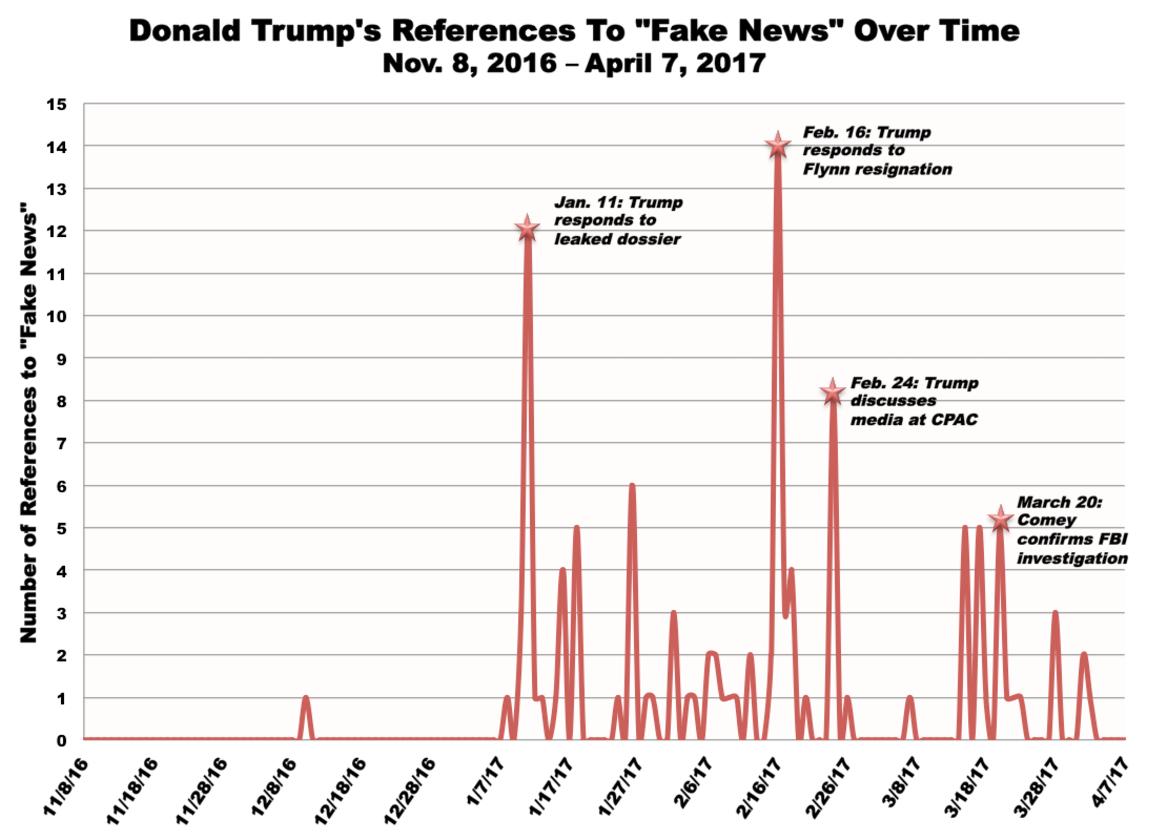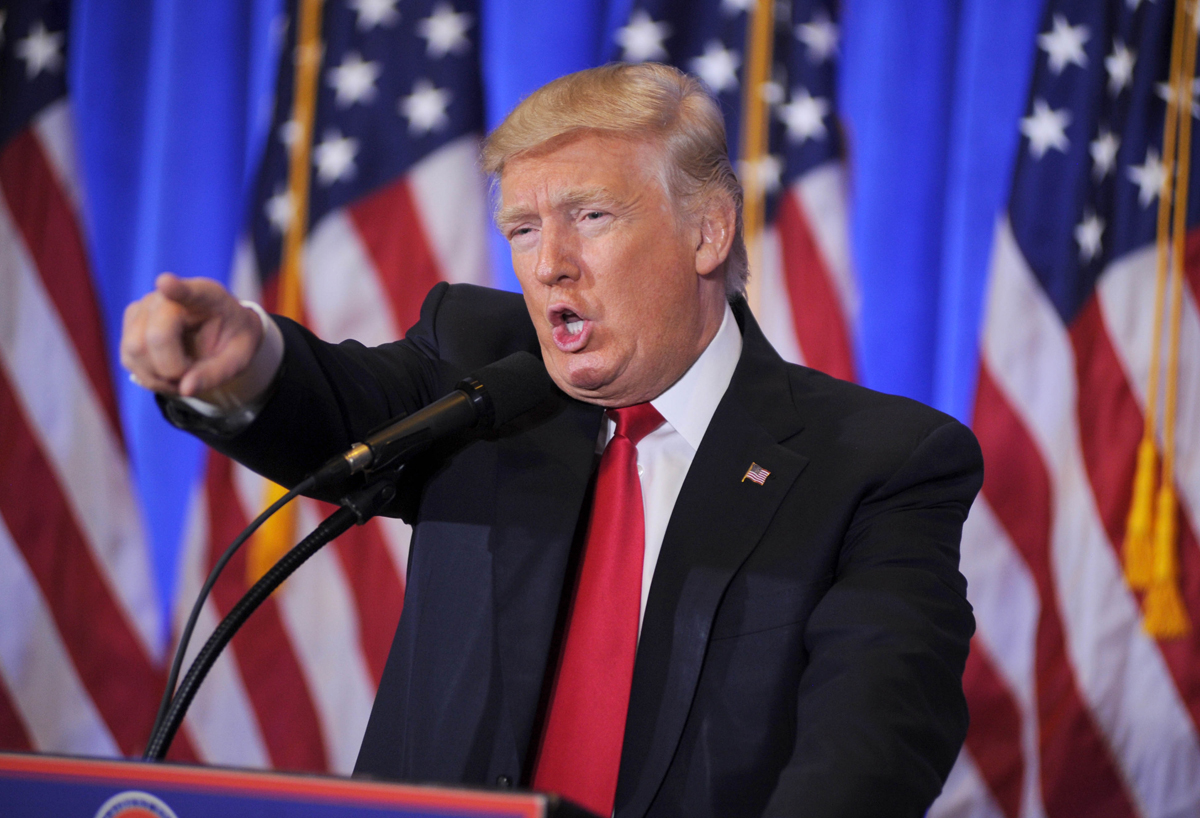President Donald Trump offers a consistently defiant response to allegations about the Kremlin’s meddling in the 2016 campaign: “fake news.”
The Reporters’ Lab at Duke University’s Sanford School for Public Policy catalogued 111 Trump statements about “fake news” over the five months following his election. That meant scouring tweets, speeches, interviews and press conferences, and then classifying each individual reference based on its topic, target and timing.
Of all the times we found Trump referring to “fake news” from Nov. 8 to April 7, 41 percent were either direct or indirect responses to news coverage about Russia’s role in the presidential campaign.
We also found that Trump used the “fake news” epithet to scold the press in general or to complain about its coverage of specific topics. How pundits and pollsters underestimated his campaign was one example. But even when Trump was specifically referring to those campaign forecasts, he only used the term seven times. No other topic came close.
“You can talk all you want about Russia, which was all a fake news, fabricated deal to try and make up for the loss of the Democrats,” Trump said during a Feb. 16 news conference, after Russia questions forced out his first national security adviser, Michael Flynn. “The press plays right into it.”
Trump first tweeted about “fake news” in December, according to the analysis of his statements by the Reporters’ Lab, where undergraduate researchers help study journalism issues and practices. But the president-elect did not use the term with any frequency until Jan. 10, when BuzzFeed published a dossier of unverified claims about his alleged activities and business connections in Russia. Trump responded with a tweet: “FAKE NEWS – A TOTAL POLITICAL WITCH HUNT!”
“Intelligence agencies should never have allowed this fake news to ‘leak’ into the public,” Trump continued the following day.
Trump also refused to take a question from a CNN reporter at a press conference because of the network’s reporting about the dossier, even though CNN did not publish or describe the document’s most salacious and unverified contents. “Not you” Trump said. “Your organization is terrible…. You are fake news.”
Over the next 12 and a half weeks, Trump regularly returned to the term to discredit news coverage about Russia and the American election.

Infographic by Riley Griffin.
Trump used the term “fake news” 19 distinct times within three days after a New York Times story reported that multiple campaign aides had been in contact Russian intelligence officials during the election. “I want to just tell you, the false reporting by the media, by you people – the false, horrible, fake reporting makes it much harder to make a deal with Russia,” he said in a press conference on Feb. 16.
On March 20, when FBI Director James Comey confirmed his agency was investigating possible collusion between Trump’s campaign and the Kremlin, Trump once again took to Twitter, citing earlier comments by the former national intelligence director. “James Clapper and others stated that there is no evidence Potus colluded with Russia,” Trump wrote. “This story is FAKE NEWS and everyone knows it!”
Trump’s tweets about “fake news” serve to “delegitimize the knowledge producing institutions we have in democratic society,” said Daniel Kreiss, an associate journalism professor at the University of North Carolina, Chapel Hill, who has studied the intersection of political rhetoric and social media.
“When it comes to Russia, Trump wants to sow doubt and create controversies around evidence,” Kreiss said. “He’s attacking the credibility of the messengers. It’s a strategy of doubt. If he can make this about a partisan attack and not a set of empirical facts about his relationship to Russia — then he’s winning.”
Blurring the lines between mainstream news reporting and fabrication, Trump has appropriated the original definition of “fake news.” The phrase came into popular use in 2016 as a way to describe the viral circulation of entirely fabricated information for financial gain. In political terms, that meant using provocative partisan clickbait to make money with online advertising.
In contrast, Trump has used “fake news” since the election to denounce established institutions or reporting that challenged his campaign and administration.
Trump’s indiscriminate use of the “fake news” label intentionally obfuscates its meaning, said Michael Cornfield, director of the Public Echoes of Rhetoric in America Project at The George Washington University Graduate School of Political Management.
“‘Fake news’ is sort of in the category of ‘political correctness’ and ‘radical Islamic Terrorism,’” Cornfield said. “It is a convenient phrase that is getting stretched to meanings away from its original one. These are phrases that are meant to ignite emotions and keep people from looking for facts and discussing facts.”
Trump also has called attention to inaccurate reporting, anonymous sourcing and the release of unverified information in the media. These common complaints about newsroom practices may not exactly constitute “fake” news, but they help Trump make his case against the press.
This communications strategy diverts attention from evidence about Russia’s role in the campaign by turning the spotlight back on the media. However, Trump’s criticism of the press is often vague and unspecific.
The Reporters’ Lab found that about 70 percent of Trump’s references to “fake news” denounced the news media in general without citing individual organizations or the specific articles that provoked his response.
The remaining 30 percent of his statements we analyzed focused on specific organizations. CNN, for example, was called out 13 times — more than any other outlet. Trump sometimes lumped multiple institutions together, as he did in one broadly aimed tweet on Feb. 17: “The FAKE NEWS media (failing @nytimes, @NBCNews, @ABC, @CBS, @CNN) is not my enemy, it is the enemy of the American People!”
Trump has not blamed “fake news” entirely on the news media. Eight of his 111 statements focused on the intelligence community. He also singled out Democrats four times. But the press is his primary target.
“When Trump attacks journalists for peddling fake news or untruths, he knows that among his core group of supporters and Republicans, people are going to be skeptical of the press,” Kreiss said. “The professional press has a legitimacy crisis.”
Undoubtedly, the public is skeptical when it comes to the news media — and Trump claims some responsibility for that.
“I think I’ve done a lot of that,” the president said in an interview with The Christian Broadcasting Network, taking personal credit for the low levels of trust in the press seen in public opinion polls. “I think I’ve brought it down. At my rallies I’ll speak, and people will start going pretty wild against [the media].”
While the American public may not trust the media, Trump has said he has their confidence. In a recent interview with Time, he navigated subjects including truth, falsehood and the so-called “fake media.” His ultimate takeaway?
“The country believes me,” Trump said.
Riley Griffin is a student researcher at the Reporters’ Lab, a research program in Duke University’s Sanford School of Public Policy that explores journalism issues and practices. Griffin is a junior who studies international relations and policy journalism. She has reported for The Huffington Post and was a fact-checker for biographer Jon Meacham’s “Destiny and Power: The American Odyssey of George Herbert Walker Bush.”






